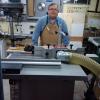I ran my treasured antique Porter Cable A3 worm-drive dry, terrible blunder that I can remedy with new gears that I managed to find and buy, but I'm stumped as to how the armature shaft is properly removed from the aft part of the frame/gear housing. I've managed to remove the front housing containing the field so the armature is exposed. The armature shaft and bearing seal can be shifted fore and aft about 1/4" in the housing, but seems to be held in place, I believe by the retaining nut (#210) aft of the worm gear. I suspect that removing this nut will release the shaft, but accessing the nut with a socket through the small oil fill hole seems like a nearly impossible task, so I'm thinking there is another way. The brass gear on the perpendicular jack shaft which is driven by the worm gear and connected to the belt drive pulley by a chain also needs to be removed and replaced. I think removing the jack shaft nut and gear on the chain side and unscrewing the cover plate below the jack shaft drive gear will free the jack shaft so that I can change the brass gear. Maybe this will also free the armature and steel worm gear.
Anyway, I'm hoping someone still active on the forum has worked on the PC A3 and can offer guidance. There is a 2012 post here byMike Meadors a forum member who apparently has done the change:
http://www.sawmillcreek.org/showthre...04-belt-sander
I'll try to contact him, but like me he apparently hasn't been active on the forum lately. If anyone else has advice, I'd appreciate hearing from you. Thanks,
Mike




 Reply With Quote
Reply With Quote
